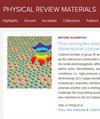Chemical reaction mechanisms of solid state ammonia and hydrogen under high pressure
IF 3.4
3区 材料科学
Q2 MATERIALS SCIENCE, MULTIDISCIPLINARY
引用次数: 0
Abstract
Ammonia is the most stable compound of nitrogen and hydrogen at ambient pressure. However, the chemical reaction of nitrogen and hydrogen is more complex and difficult to explore at high pressures. Here, we have performed extensively structural searches of ammonia-hydrogen compounds based on particle swarm optimization algorithms and first principles calculations. The calculated results show that the main reaction products of nitrogen and hydrogen under high pressure can be divided into two categories: high-energy density material (HEDM) and hydrogen storage material (HSM). Three different phases of are potential HEDMs, which are found to be stable or metastable at 40 GPa to 300 GPa, and metastable at ambient pressure with energy density of about . The phase of is an outstanding HSM with ultrahigh hydrogen storage (41.7 wt%) and release (29.2 wt%) capacities. These findings offer significant insights into the structural arrangements and chemical bonding patterns of ammonia-hydrogen compounds at high pressure, and suggest potential experimental avenues for elucidating how diverse metastable structures with distinct properties might be existed in planetary interiors.

高压下固态氨和氢的化学反应机理
氨是氮和氢在常压下最稳定的化合物。然而,氮和氢的化学反应更为复杂,在高压下难以探索。在此,我们基于粒子群优化算法和第一性原理计算,对氨氢化合物进行了广泛的结构搜索。计算结果表明,氮气和氢气在高压下的主要反应产物可分为两类:高能量密度材料(HEDM)和储氢材料(HSM)。NH4 的三种不同相是潜在的 HEDM,它们在 40 GPa 至 300 GPa 下稳定或蜕变,在常压下蜕变,能量密度约为 2.15kJ/g∼3.86kJ/g。NH10 的 Pm 相是一种出色的 HSM,具有超高的储氢(41.7 wt%)和释氢(29.2 wt%)能力。这些发现为了解高压下氨氢化合物的结构排列和化学键模式提供了重要启示,并为阐明行星内部可能存在具有独特性质的多种可蜕变结构提供了潜在的实验途径。
本文章由计算机程序翻译,如有差异,请以英文原文为准。
求助全文
约1分钟内获得全文
求助全文
来源期刊

Physical Review Materials
Physics and Astronomy-Physics and Astronomy (miscellaneous)
CiteScore
5.80
自引率
5.90%
发文量
611
期刊介绍:
Physical Review Materials is a new broad-scope international journal for the multidisciplinary community engaged in research on materials. It is intended to fill a gap in the family of existing Physical Review journals that publish materials research. This field has grown rapidly in recent years and is increasingly being carried out in a way that transcends conventional subject boundaries. The journal was created to provide a common publication and reference source to the expanding community of physicists, materials scientists, chemists, engineers, and researchers in related disciplines that carry out high-quality original research in materials. It will share the same commitment to the high quality expected of all APS publications.
 求助内容:
求助内容: 应助结果提醒方式:
应助结果提醒方式:


